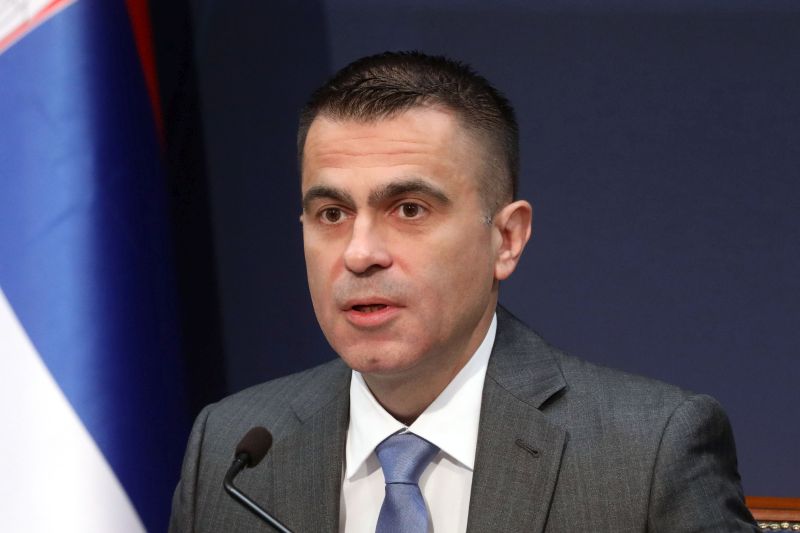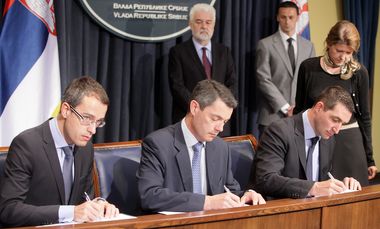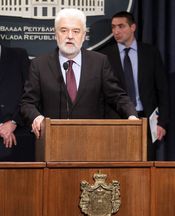- Serbia
Get to know Serbia
- Citizens
Culture and science
Health services
Pension and disability insurance
- Business
Employment
Economy
- Media
- Government
- Contact
Keep in touch
Contact form
Back
Keepin touch
Whether you have a question, comment, suggestion or any problem in the purview of the government, send us your message and we will try to respond as soon as possible. If your problem is not in our purview, we will forward your message to the relevant institution.
Q:
A:
Memorandum on building solar park in Serbia signed
Belgrade,
8 May 2012
Minister of Environment, Mining and Spatial Planning Oliver Dulic and board members of the Securum Equity Partners Europe Alessio Colussi and Ivan Matejak today signed a Memorandum on the construction of a solar park in Serbia, the largest individual solar park in the world.
Following the signing, Dulic said that the 1,000 MW solar park will span 3,000 hectares and the investment is worth around €2 billion.
He added that the electricity produced in the solar park will be exported to the EU, noting that the construction will last three to five years and require 2,500–3,000 workers. Once the park is operational, it will hire 500–600 people.
Dulic explained that Serbia’s obligation is to provide the land and infrastructure and it will concede the land for a 25 year period free of any charge.
Serbia will not have any financial obligations in this investment and over the next 20 years it will garner around €750 million in taxes, he specified.
The Minister said that Serbia will not be under any obligation to purchase the electricity produced in the solar park under subsidised prices and the land where the park will be built is not agricultural land of good quality.
The MX Group, a major solar panel producer in Europe, will be engaged in the construction, he said, adding that the company will most likely move its European production to Serbia. If their contractors follow, they will create 1,000 new jobs in Serbia, he added.
He added that the electricity produced in the solar park will be exported to the EU, noting that the construction will last three to five years and require 2,500–3,000 workers. Once the park is operational, it will hire 500–600 people.
Dulic explained that Serbia’s obligation is to provide the land and infrastructure and it will concede the land for a 25 year period free of any charge.
Serbia will not have any financial obligations in this investment and over the next 20 years it will garner around €750 million in taxes, he specified.
The Minister said that Serbia will not be under any obligation to purchase the electricity produced in the solar park under subsidised prices and the land where the park will be built is not agricultural land of good quality.
The MX Group, a major solar panel producer in Europe, will be engaged in the construction, he said, adding that the company will most likely move its European production to Serbia. If their contractors follow, they will create 1,000 new jobs in Serbia, he added.
Prime Minister Mirko Cvetkovic, who attended the signing, stressed that the important thing is that the project is completely export-oriented, that it will hire domestic workforce and bring new high technology to the country, which is why the government is endorsing it.
The solar panels will be imported but there is a possibility that their production be moved to Serbia, he added.
State Secretary of Environment, Mining and Spatial Planning Bojan Djuric stated that the annual number of hours of sunshine increases as we move further south, which means that the area from Nis to the Macedonian border would be the most suitable for a solar park.
Djuric said that it is logical that municipalities in this area have shown the greatest interest in the project – the Pirot District, Pester plateau, Sjenica. The solar park could be built on abandoned pastures
Matejak stated that the construction may begin early in 2013, provided that suitable land parcel is obtained, as well as the necessary permits.
He said that his company chose Serbia because of the annual number of sun hours, which is by 40% higher than in other parts of southeast Europe, adding that they are still looking for the location.
Another reason for choosing Serbia is its good industrial history, highly qualified workforce and readiness to cooperate at all levels of government, he added.
Colussi stressed that the project was designed to be sustainable and competitive, bearing in mind the global price of electricity.
The solar panels will be imported but there is a possibility that their production be moved to Serbia, he added.
State Secretary of Environment, Mining and Spatial Planning Bojan Djuric stated that the annual number of hours of sunshine increases as we move further south, which means that the area from Nis to the Macedonian border would be the most suitable for a solar park.
Djuric said that it is logical that municipalities in this area have shown the greatest interest in the project – the Pirot District, Pester plateau, Sjenica. The solar park could be built on abandoned pastures
Matejak stated that the construction may begin early in 2013, provided that suitable land parcel is obtained, as well as the necessary permits.
He said that his company chose Serbia because of the annual number of sun hours, which is by 40% higher than in other parts of southeast Europe, adding that they are still looking for the location.
Another reason for choosing Serbia is its good industrial history, highly qualified workforce and readiness to cooperate at all levels of government, he added.
Colussi stressed that the project was designed to be sustainable and competitive, bearing in mind the global price of electricity.
-
 Belgrade, 22 January 2025
Belgrade, 22 January 2025Egypt one of Serbia’s closest partners on international stage
-
 Belgrade, 9 July 2024
Belgrade, 9 July 2024Support for 104 associations in diaspora that preserve Serbian language, culture
-
 Belgrade, 15 April 2024
Belgrade, 15 April 2024Competition for StarTech grants open until 31 May
-
 Belgrade, 2 October 2023
Belgrade, 2 October 2023Serbia respects Resolution 1244 and will do everything to preserve peace
-
 Belgrade, 13 September 2023
Belgrade, 13 September 2023Day of Serbian Unity to be celebrated outside borders of Serbia, Republika Srpska for the first time
-
 Belgrade, 8 August 2023
Belgrade, 8 August 2023RSD 24.2m in state aid paid out to citizens affected by storm
-
 Belgrade, 17 June 2023
Belgrade, 17 June 2023Belgrade is doing everything to preserve peace in Kosovo and Metohija
-
 Belgrade, 15 June 2023
Belgrade, 15 June 2023Slovenia will continue to support Serbia on its way to EU
-
 Belgrade, 5 May 2023
Belgrade, 5 May 2023Emergency measures, tightening of conditions for possessing weapons
-
 Belgrade, 3 May 2023
Belgrade, 3 May 2023Three days of mourning in Serbia over tragedy at Vladislav Ribnikar primary school



